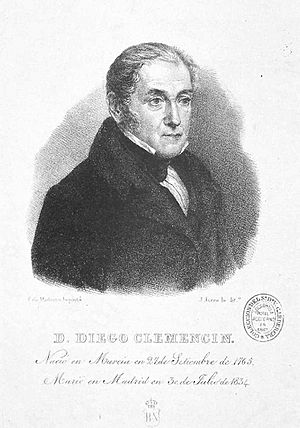Diego Clemencín facts for kids
Quick facts for kids
The Most Excellent
Diego Clemencín
|
|
|---|---|
 |
|
| Born |
Diego Clemencín y Viñas
27 September 1765 Murcia, Spain
|
| Died | 10 June 1834 (aged 68) Madrid, Spain
|
| Seat I of the Real Academia Española | |
| In office 22 March 1814 – 10 June 1834 |
|
| Preceded by | Francisco Patricio de Berguizas |
| Succeeded by | Jerónimo del Campo y Roselló |
Diego Clemencín y Viñas (born September 27, 1765 – died June 10, 1834) was an important Spanish scholar and politician. He was born in Murcia, Spain. Diego studied at the Colegio de San Fulgencio. Even though he first thought about becoming a priest, he decided to follow a different path. In 1788, he moved to Madrid and started working as a tutor for the children of a noble family. During this time, he also spent a lot of time studying old history and artifacts, which is called archaeology.
Contents
Diego Clemencín's Career and Contributions
Early Career and Challenges
In 1807, Diego Clemencín became the editor of the Gaceta de Madrid, which was a major newspaper. The next year, he faced a difficult situation. He published an article that supported his country, which angered Joachim Murat, a powerful leader at the time. Because of this, Diego had to flee to Cadiz to stay safe.
While in Cadiz, he worked in different roles for the government. However, when a new government came to power in 1814, they removed him from his positions. This new government wanted to go back to older ways of ruling.
Political Roles and Exile
Later, from 1820 to 1823, when a more liberal government was in charge, Clemencín became the colonial minister. This meant he helped manage Spain's colonies. After this period, he was forced to live away from Spain until 1827.
Work on Don Quixote
In 1833, Diego Clemencín published the first part of his special edition of Don Quixote. This was a very famous Spanish novel. His work on Don Quixote was highly respected. People recognized how good his work was, and he was appointed as a royal librarian. This was a great honor, but he did not get to enjoy it for long, as he passed away shortly after, on June 10, 1834.
Other Important Writings
Diego Clemencín's detailed notes and comments on Don Quixote were very valuable for his time. He also wrote an interesting piece called Elogio de la reina Isabel la Católica. This work praised Queen Isabella I of Castile. It was published as part of the Memorias of the Spanish Academy of History. He had been chosen to join this important group on September 12, 1800.
See also
 In Spanish: Diego Clemencín para niños
In Spanish: Diego Clemencín para niños

